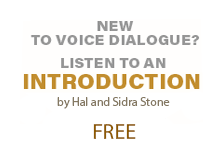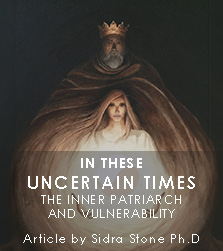by Hal Stone, Ph.D. & Sidra Stone, Ph.D.
This article is the third in a series of four written in 1994 for the journal, Psychotherapy in Australia. It describes how to use Voice Dialogue and was written for mental health professionals only.
Voice Dialogue is the method that enables one to contact, understand, and work directly with the many selves that make up the human psyche. It is precise, like a laser beam, enabling the clinician, or a facilitator, to focus upon a specific area of psyche for exploration, understanding, and healing. Voice Dialogue is a tool that is compatible with most psychological systems and can be used with a wide variety of backgrounds. Of course, one’s individual theoretical framework will undoubtedly affect the choice of selves to be explored and will impact the way in which the information gained by this method is processed.
It is interesting to note that Voice Dialogue grew from our own relationship and our own needs for a new way to learn about one another; it was not developed in a clinical setting. Therefore, it is totally accepting and non-judgmental. It is not oriented towards pathology nor is it focused upon discovering what is wrong. It is an exploration of what is, without assumptions as to how things should be. When using this method, one assumes that all selves are to be honored; that each one has both positive and negative aspects. The basic attitude of the “facilitator”, i.e., the person who facilitates this process, is one of interest and acceptance.
The Basic Principles
1. An attitude of acceptance and respect is extremely important in the Voice Dialogue facilitation process. The facilitator is an explorer, an interested observer who is trying to discover as much as possible about each self. The selves are extremely sensitive to the feelings and judgments of the facilitator and they will not respond if they sense disapproval or manipulation. This is a method that will not work effectively unless it is used with a proper attitude. When it is used properly, however, it provides quick and easy access to much of the psyche.
2. When facilitating using the Voice Dialogue method, we are not trying to change selves, to get rid of them, or to help them to grow up and be more sensible. There should be no agenda. Changes will take place, growth will occur, there will be healing, but these cannot be the aims of the facilitator.
3. The facilitator does not negotiate amongst selves. There is no attempt to get the selves to agree on anything. Each self is different, and these differences are to be respected. Instead of trying to get the selves to agree, the facilitator helps each self to clarify its views and to give as much information as possible. Thus, the subject (or client) learns to live with the tension of opposing viewpoints represented by these selves and to make decisions which take these opposites into consideration.
4. The aim in Voice Dialogue is to expand the client’s ability to make choices in life rather than to behave in an automatic and unconscious fashion. This is the aim of most therapeutic systems, however it is conceptualized.
For us, this ability to have choice when making decisions, to see both sides of an issue and to behave with greater awareness and consciousness is carried by an ever-evolving aspect of consciousness that we call an “Aware Ego” . We see this Aware Ego as separate from the selves, aware of them and of the effect that they have, and able to make choices by taking the views of opposing selves into consideration.
The Method
1. Relax
First relax, get centered and quiet your own inner pusher and critic. Ideally these sessions are conducted in a relaxed yet alert fashion. The emphasis is upon the subject, not upon your performance as the facilitator. You will be observing the subject’s energy patterns and looking at physiological, emotional and linguistic cues. People love to do Voice Dialogue and if you remain unselfconscious, this method is quite simple.
2. Mapping the Psyche
The first step in this process is to create a “psychic map”. By this, we mean you as the facilitator will identify some of the primary selves that are operating in the subject’s life and the selves that carry the opposite characteristics that are disowned. This is done by listening as the subject discusses some aspect of life or a particular issue that is troublesome. It is important to get a picture of the territory that is to be explored before beginning so that you have an idea of how the selves are aligned and what might be expected in the facilitation.
This “psychic map” is open to constant revision. You may keep this “map” abstract as a concept, or you might actually draw a diagram or picture for yourself and your client. Your own clinical background will determine the way in which you conceptualize this psychic map.
Listen for the primary selves as the subject discusses values and characteristic behaviors. The astute clinician will easily detect these primary selves. For instance, phrases like: “I never seem to get enough done”, “I’m always in a rush”, “There aren’t enough hours in the day” suggest that the Pusher is a primary self. Thus, the facilitator would see the Pusher as a primary self and the “Lazybones” or “Beach Bum” as a disowned self. These maps can be as simple or as complex as you wish. At the most simple, you will be thinking in terms of primary and disowned selves and of the vulnerable child which is being protected.
Listen for the disowned selves as the subject criticizes others. When a client says critically of someone else: “She is so self-involved and inconsiderate. Her children already have problems.” it is quite likely that this client has disowned her own selfishness and is unable to pay attention to her own needs. A man who says angrily of another: “He is a tyrant” has probably disowned his own power and characteristically defers to the requirements of others.
3. Introduce the idea of selves and see how the client responds.
For example, “It sounds like there’s a part of you that’s always in a hurry and trying to do more even when you are getting tired and want to rest.” If you hit upon a primary self, most people will respond easily to this suggestion. “Yes, that’s me. I can always do a little bit more.”
Another way of doing this is to speak about two sides of a conflict as two different selves. For instance: “So, one part of you wants to go to school and train to be a teacher, but another part is afraid that if you are away from home too much, your family will suffer.” If the client responds positively, you are in a position to talk to both selves. “the part that wants to go to school” and “the part that thinks it is important to put the needs of the family first”. Voice Dialogue is not for everyone, and the client must be able to think in terms of selves. As the client becomes accustomed to thinking in terms of selves, it is a small step to move him or her into a position of talking to them.
4. Begin Voice Dialogue by Physically Separating the Self
When you are ready to talk to a specific self, simply ask your client to move to another space in the room. The client, or subject, then changes position or seats or simply moves his/ her chair. The original position of the client’s chair is taken as the position of the client’s ego or the Aware Ego.
This movement away from the original position is very important even though at first it may feel somewhat artificial. This aides in the separation and the objectification of the selves. It is also a great help for you as the facilitator because you will be able to use the positions of the selves to identify them and to see how they relate to one another. As the selves position themselves about the room, they actually create a psychic map. The selves will return to their individual positions when you talk with them on subsequent occasions.
Each self has its own position and the selves will play out their dramas around the Aware Ego. The Protector Controller might sit between you and the client’s original chair. The vulnerable child invariably sits in a corner or curls up on a couch (often with a pillow if this is available). The inner critic has a tendency to stand up and survey the entire scene to get a better perspective. Angry selves often prefer to pace around the room.
5. Facilitation
Once the self has taken up its position in the room, the facilitator can begin to speak with it. Simply talk with the self as though it were a real person because, as you will discover, it is. As we mentioned at the beginning, your attitude will be most important at this time. The more curious, open minded, empathetic you can be, the better this will work. Feel free to use all your clinical skills in interviewing the self. It will be appreciated.
The most amazing discovery is that these selves are delighted to talk. So relax and enjoy. If this becomes tedious or burdensome, stop. Either you are trying too hard, or you have lost the self and are talking to a protective self that is trying to keep you away from something that seems too threatening.
6. Begin with the Primary Selves
The most important work that you will do is to separate the subject from his or her primary selves. Although the work with disowned material may be more dramatic, it is the separation from the primary self that is the essential goal. If the Aware Ego does not successfully separate from the primary self, then it will just move in again when the client leaves your office and will resume control of the client’s life.
In later sessions, the disowned selves can be explored. This is done only after the primary selves are understood and their role in the client’s life is fully appreciated. The primary selves are an amazing source of information about the difficulties and dangers that have faced your client. They know about the vulnerability, the fears, and the inadequacies that need protection. Once the primary selves are aware that the client is ready to accept responsibility, they will allow you to work with the disowned selves.
After working with a disowned self, take time to check back with the primary self that represents the opposite characteristics. This emphasis upon the primary selves keeps the work safe and allows progress at a rate that is appropriate to your client.
7. Observe Changes in the Energy Patterns
As you do this work, you will become even more sensitized to very subtle changes in your client. The astute clinician has always been sensitive to shifting selves or energy patterns. You will find that the more you use Voice Dialogue, the more sensitized you will become to these shifts. You will practically begin to see when one or another of the selves takes over control of the psyche.
As you observe changes in the energy patterns, you will notice when you are moving out of contact with a self. Perhaps another has come in, or perhaps it is time to end this particular part of the facilitation.
8. Altered States of Consciousness
When you are talking to a self, the subject is in an altered state of awareness. There is no ego present to protect your client. Treat this with respect and caution. Try to avoid interruptions and do not leave the client alone when in a self. If it is necessary to leave, return the subject to the place of the ego and separate him or her from the self that you have been exploring.
It is best to return to a primary self before ending the session. This helps to anchor the work. Do not leave the client or subject in a self at the end of a session. Always return to the position of the ego (or Aware Ego). Leave 10 minutes or more to summarize and discuss what has happened. This gives the subject a chance to center and to prepare to go back out in the world.
9. Summarize for the Awareness
The Awareness is a position of non-judgmental consideration of the selves. It gives an overview that we see as similar to the witness state that people achieve in meditation.
In order to develop this Awareness, ask your client to stand beside you facing the selves and then summarize the important points of the session for him/her. You can be as brief or detailed as you wish, but be objective. This gives clearly delineated insights and enables the client or subject to “see” the selves, their roles and their interactions. Sometimes during this summary, additional insights or realizations will spontaneously emerge as the client “looks” at the selves in this way.
10. Return to the Ego Position (the Aware Ego) for Centering and Integration
At the end of the session, always return the client to the original chair or position. Leave adequate time (at least 10 minutes) for discussion. This is a time for you to help your client to separate from the selves that have spoken and to integrate the work that has been done. It is important to discuss what has happened and to encourage the subject to speak about his or her reactions.
If the session has been particularly intense, it would be appropriate to suggest that the client take some extra time before returning to the daily routine. This is a time to be quiet and to savor the experience, to take a walk, to get something to eat, or to have a cup of coffee or tea.
General Considerations
In Voice Dialogue, never go beyond your level of comfort either as a facilitator or as a subject. As a therapist, we suggest that you let your clients know that they are not expected to push beyond what seems comfortable for them.
Taping these sessions can be extremely valuable. The client is able to listen to the selves after the session is over and this can induct even greater awareness and insight.
If possible, we suggest that sessions last at least one and one half hours. This gives adequate time for the selves to emerge clearly and then allows additional time at the end of the session for discussion and centering.
We cannot do justice to the complexity of the Voice Dialogue process in such a brief article. However, we have covered the basic information. For a more complete explanation of this work and for transcripts of typical Voice Dialogue sessions, please refer to our book, Embracing Our Selves.
In Closing
Voice Dialogue as an instrument is the same for everyone, but the sound of the music it plays is different for each of us. Each of us brings to this instrument our own individual background or belief system and a specific set of interests and talents. We have different levels of maturity and our own specific skills. Thus, although the instrument of Voice Dialogue is the same for us all, the music that each person produces will be unique. © 1994







